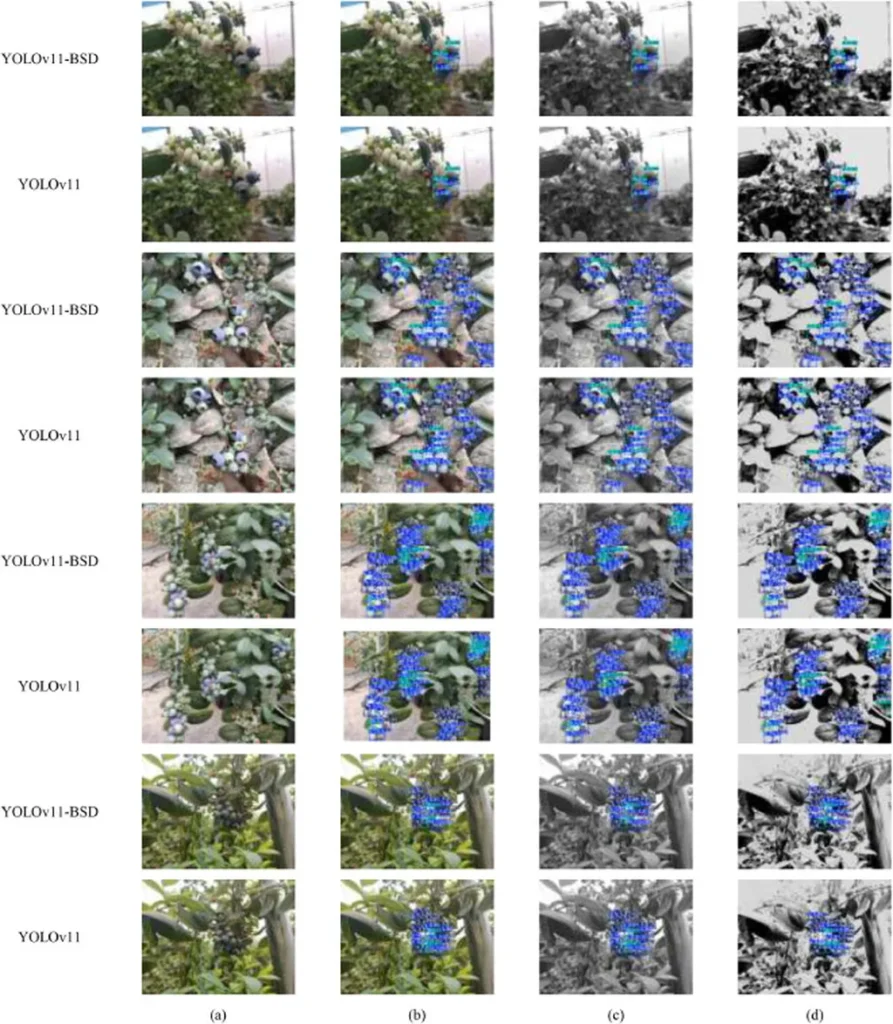In the heart of Shanxi, China, a groundbreaking study led by Runqing Zhang from the School of Software at Shanxi Agricultural University is set to revolutionize the blueberry industry. The research, published in the journal *Smart Agricultural Technology* (translated as *智能农业技术*), introduces YOLOv11-BSD, a novel model designed to accurately detect blueberry maturity under simulated nighttime conditions. This innovation addresses a critical gap in the berry industry, where nighttime harvesting is preferred for preserving freshness, but current models struggle with low-light conditions.
The blueberry industry faces a significant challenge: accurately classifying berry maturity affects quality, shelf life, and processing efficiency. Traditional methods rely on deep learning models that perform well under good lighting but falter at night. “Nighttime harvesting is crucial for maintaining the freshness of blueberries,” explains Zhang. “However, capturing high-quality images in the dark is tough, and existing models often fail to extract key features effectively.”
To tackle these issues, Zhang and his team developed YOLOv11-BSD, an improved model that enhances feature representation and robustness. The model incorporates several key improvements: a Bi-directional Feature Attention Mechanism to strengthen feature representation, an Squeeze-and-Excitation mechanism to focus on critical channel features, an optimized PANet feature fusion pathway for better multi-scale feature integration, and a DySample module to resolve feature adaptation issues during upsampling.
One of the most innovative aspects of this research is the introduction of the Relative Causal Effect metric. This metric provides a comprehensive and accurate evaluation of model robustness from a causal inference perspective, addressing the limitations of current evaluation methods.
For data preparation, the team used image enhancement techniques to simulate nighttime lighting conditions from daytime-captured blueberry images. They then combined these simulated nighttime images with the original daytime images for model training. The results were impressive: the improved YOLOv11-BSD model showed significant improvements in both accuracy and robustness. Its Precision reached 89%, a 5.4% increase, and its Recall reached 85.7%, a 5.6% increase. The mean Average Precision at IoU=0.50 reached 91.8%, a 4.7% increase, and the mean Average Precision across IoU thresholds from 0.50 to 0.95 reached 80.8%, a 5.7% increase. Meanwhile, the Relative Causal Effect dropped to 18.98%, a 4.26% decrease.
The implications of this research are far-reaching. “This model not only improves the accuracy of blueberry maturity detection but also enhances the robustness of the model, making it more reliable for real-world applications,” says Zhang. The commercial impacts are substantial, as more accurate maturity detection can lead to better quality control, reduced waste, and increased efficiency in processing.
Looking ahead, this research could shape future developments in precision agriculture. The use of causal analysis in evaluating model robustness sets a new standard for assessing deep learning models in agricultural applications. As Zhang notes, “This approach can be extended to other crops and conditions, paving the way for more intelligent and efficient agricultural practices.”
In the rapidly evolving field of agritech, YOLOv11-BSD stands out as a beacon of innovation. Its success highlights the potential of combining deep learning with causal analysis to address real-world challenges in the agricultural sector. As the industry continues to embrace technology, models like YOLOv11-BSD will play a pivotal role in driving progress and improving outcomes for farmers and consumers alike.

